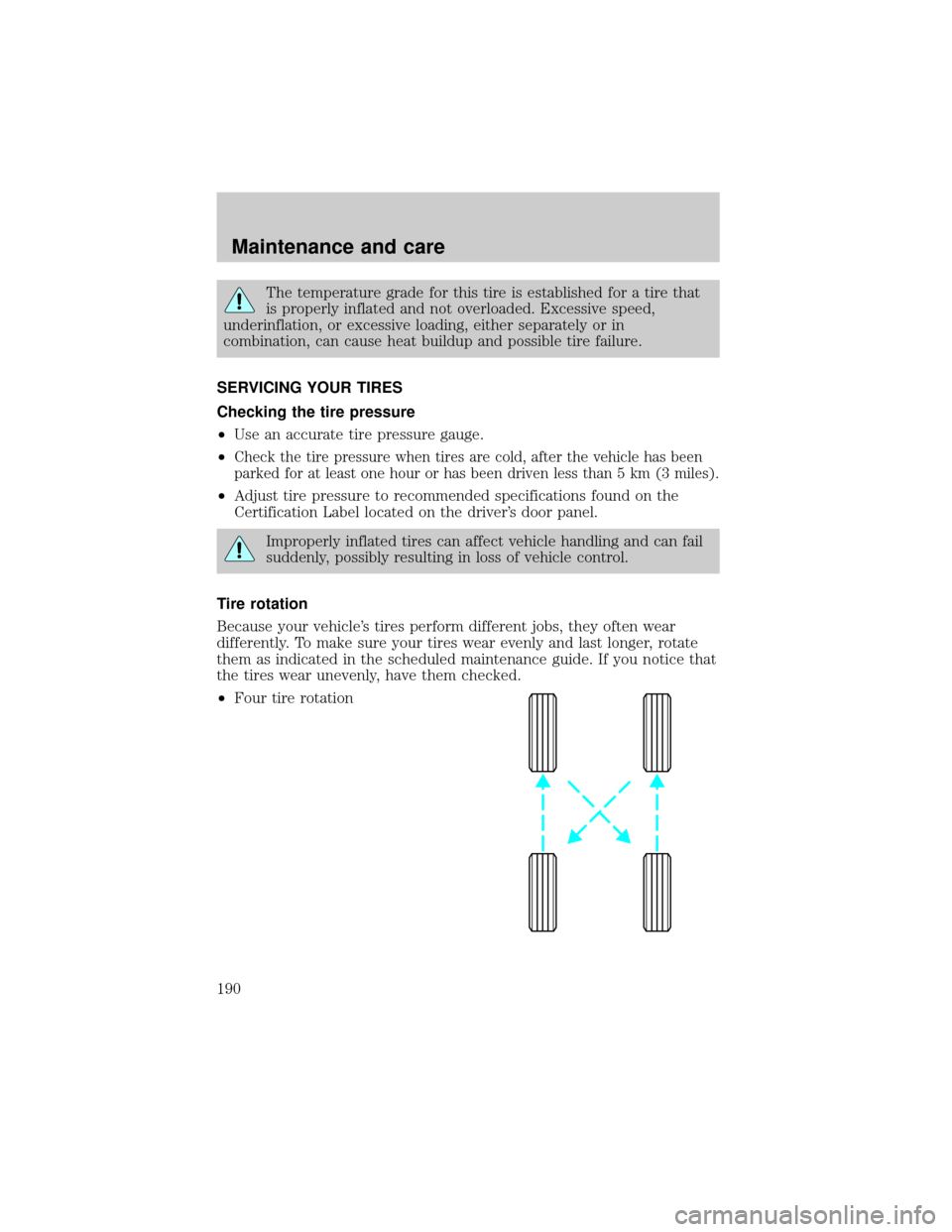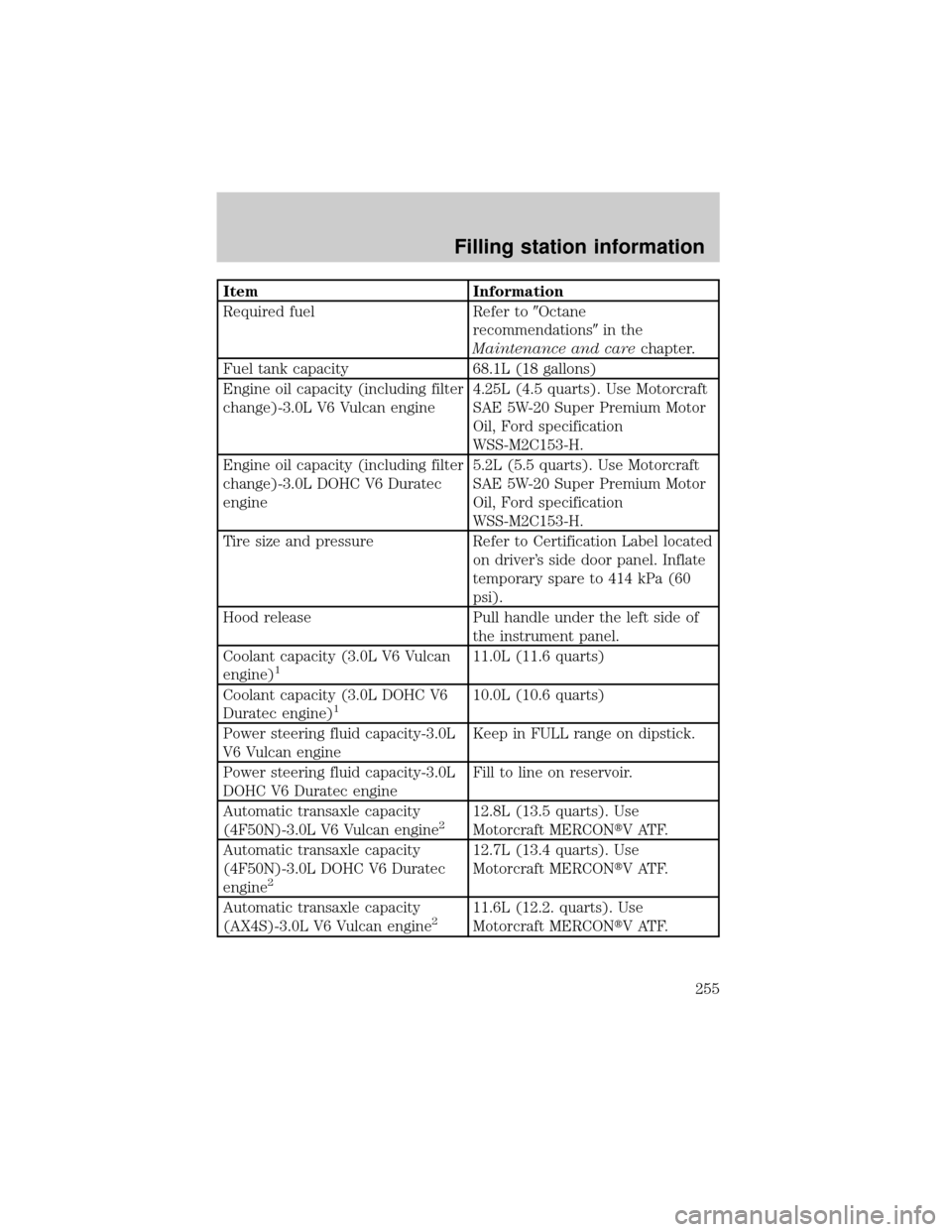tire pressure FORD TAURUS 2001 4.G Owners Manual
[x] Cancel search | Manufacturer: FORD, Model Year: 2001, Model line: TAURUS, Model: FORD TAURUS 2001 4.GPages: 256, PDF Size: 2.31 MB
Page 139 of 256

Once through the water, always try the brakes. Wet brakes do not stop
the vehicle as effectively as dry brakes. Drying can be improved by
moving your vehicle slowly while applying light pressure on the brake
pedal.
Driving through deep water where the transmission vent tube is
submerged may allow water into the transmission and cause
internal transmission damage.
TRAILER TOWING
Your vehicle is classified as a light duty towing vehicle. The amount of
weight you can safely tow depends on the type of engine you have in
your vehicle. Your vehicle does not come from the factory fully equipped
to tow. No towing packages are available through Ford or
Mercury/Lincoln dealers. Do not tow a trailer until your vehicle has been
driven at least 800 km (500 miles). If towing with a station wagon, inflate
the rear tires to 35 psi.
Towing a trailer places an additional load on your vehicle's engine,
transaxle, brakes, tires and suspension. Inspect these components
carefully after towing.
In order to identify your vehicle's engine, refer toIdentifying
components in the engine compartmentin theMaintenance and
Carechapter.
The amount of weight that you can tow depends on the type of engine in
your vehicle. See the following charts:
3.0L 2-Valve Vulcan Engine
Model Passenger
Load - #/kg (lbs.)Luggage
Load - kg (lbs.)Max Trailer
Wt.- kg (lbs.)
Sedan 5/340 (750) 0 365 (800)
4/270 (600) 70 (150) 365 (800)
2/135 (300) 70 (150) 500 (1 100)
2/135 (300) 0 565 (1 250)
Wagon 4/270 (600) 0 365 (800)
2/135 (300) 70 (150) 430 (950)
2/135 (300) 0 500 (1 100)
The above chart is based on the specified vehicle at a maximum GCW
(Vehicle weight + Trailer weight) equal to 2 245 kg (4 950 lbs.).
Driving
139
Page 190 of 256

The temperature grade for this tire is established for a tire that
is properly inflated and not overloaded. Excessive speed,
underinflation, or excessive loading, either separately or in
combination, can cause heat buildup and possible tire failure.
SERVICING YOUR TIRES
Checking the tire pressure
²Use an accurate tire pressure gauge.
²
Check the tire pressure when tires are cold, after the vehicle has been
parked for at least one hour or has been driven less than 5 km (3 miles).
²Adjust tire pressure to recommended specifications found on the
Certification Label located on the driver's door panel.
Improperly inflated tires can affect vehicle handling and can fail
suddenly, possibly resulting in loss of vehicle control.
Tire rotation
Because your vehicle's tires perform different jobs, they often wear
differently. To make sure your tires wear evenly and last longer, rotate
them as indicated in the scheduled maintenance guide. If you notice that
the tires wear unevenly, have them checked.
²Four tire rotation
Maintenance and care
190
Page 192 of 256

Follow these guidelines when using snow tires and chains:
²Use only cable type chains offered by Ford as an accessory or
equivalent. SAE class ªSº or other conventional link type chains may
cause damage to the vehicle's wheel house and/or body.
²Install cable chains securely, verifying that the cables do not touch any
wiring, brake lines or fuel lines.
²Drive cautiously. If you hear the cables rub or bang against your
vehicle, stop and re-tighten the cables. If this does not work, remove
the cables to prevent damage to your vehicle.
²If possible, avoid fully loading your vehicle.
²Remove the tire cables when they are no longer needed. Do not use
tire cables on dry roads.
²The suspension insulation and bumpers will help prevent vehicle
damage. Do not remove these components from your vehicle when
using snow tires and cables.
²Do not exceed 48 km/h (30 mph) with tire cables on your vehicle.
WHAT YOU SHOULD KNOW ABOUT AUTOMOTIVE FUELS
Important safety precautions
Do not overfill the fuel tank. The pressure in an overfilled tank
may cause leakage and lead to fuel spray and fire.
The fuel system may be under pressure. If the fuel filler cap is
venting vapor or if you hear a hissing sound, wait until it stops
before completely removing the fuel filler cap. Otherwise, fuel may
spray out and injure you or others.
If you do not use the proper fuel filler cap, excessive pressure or
vacuum in the fuel tank may damage the fuel system or cause
the fuel cap to disengage in a collision, which may result in possible
personal injury.
Automotive fuels can cause serious injury or death if misused or
mishandled.
Maintenance and care
192
Page 201 of 256

²Using the air conditioner or defroster may reduce fuel economy.
²You may want to turn off the speed control in hilly terrain if
unnecessary shifting between third and fourth gear occurs.
Unnecessary shifting of this type could result in reduced fuel
economy.
²Warming up a vehicle on cold mornings is not required and may
reduce fuel economy.
²Resting your foot on the brake pedal while driving may reduce fuel
economy.
²Combine errands and minimize stop-and-go driving.
Maintenance
²Keep tires properly inflated and use only recommended size.
²Operating a vehicle with the wheels out of alignment will reduce fuel
economy.
²Perform all regularly scheduled maintenance items. Follow the
recommended maintenance schedule and owner maintenance checks
found in your vehicle scheduled maintenance guide.
Conditions
²Heavily loading a vehicle or towing a trailer may reduce fuel economy
at any speed.
²Carrying unnecessary weight may reduce fuel economy (approximately
0.4 km/L [1 mpg] is lost for every 180 kg [400 lb] of weight carried).
²Adding certain accessories to your vehicle (for example bug
deflectors, rollbars/light bars, running boards, ski/luggage racks) may
reduce fuel economy.
²Using fuel blended with alcohol may lower fuel economy.
²Fuel economy may decrease with lower temperatures during the first
12±16 km (8±10 miles) of driving.
²Driving on flat terrain offers improved fuel economy as compared to
driving on hilly terrain.
²Transmissions give their best fuel economy when operated in the top
cruise gear and with steady pressure on the gas pedal.
²Close windows for high speed driving.
Maintenance and care
201
Page 248 of 256

Servicing your vehicle ..............162
Spark plugs,
specifications .....................222, 226
Specification chart,
lubricants ...........................224, 226
Speed control ..............................53
Speedometer ...............................14
Starting your vehicle ........122, 124
jump starting ..........................156
Steering wheel
tilting .........................................58
T
Tachometer .................................15
Tires ...........................152, 188±190
changing ..........................152±153
checking the pressure ............190
replacing ..................................191
rotating ....................................190
snow tires and chains ............191
tire grades ...............................189
treadwear ................................189
Towing .......................................139
recreational towing .................142
trailer towing ..........................139
wrecker ....................................161
Traction control ..................52, 130
active light ..................................8
Transaxle
automatic operation ...............132
fluid, refill capacities ..............223
lubricant specifications ..........226
Transmission
fluid, checking and adding
(automatic) .............................178lubricant specifications ..........224
Trip odometer .............................16
Trunk .........................67, 69, 71, 83
remote release ..........................66
Turn signal ..............................8, 56
V
Vehicle dimensions ...................226
Vehicle Identification Number
(VIN) ..........................................229
Vehicle loading ..........................137
Ventilating your vehicle ...........126
W
Warning chimes .....................13±14
Warning lights (see Lights) .........8
Washer fluid ..............................170
Water, Driving through .............138
Windows
power .........................................62
rear wiper/washer .....................57
Windshield washer fluid and
wipers
checking and adding fluid .....170
checking and cleaning ....187±188
liftgate reservoir .....................171
operation ...................................56
replacing wiper blades ...........188
Wrecker towing .........................161
Index
248
Page 255 of 256

Item Information
Required fuel Refer to9Octane
recommendations9in the
Maintenance and carechapter.
Fuel tank capacity 68.1L (18 gallons)
Engine oil capacity (including filter
change)-3.0L V6 Vulcan engine4.25L (4.5 quarts). Use Motorcraft
SAE 5W-20 Super Premium Motor
Oil, Ford specification
WSS-M2C153-H.
Engine oil capacity (including filter
change)-3.0L DOHC V6 Duratec
engine5.2L (5.5 quarts). Use Motorcraft
SAE 5W-20 Super Premium Motor
Oil, Ford specification
WSS-M2C153-H.
Tire size and pressure Refer to Certification Label located
on driver's side door panel. Inflate
temporary spare to 414 kPa (60
psi).
Hood release Pull handle under the left side of
the instrument panel.
Coolant capacity (3.0L V6 Vulcan
engine)
111.0L (11.6 quarts)
Coolant capacity (3.0L DOHC V6
Duratec engine)
110.0L (10.6 quarts)
Power steering fluid capacity-3.0L
V6 Vulcan engineKeep in FULL range on dipstick.
Power steering fluid capacity-3.0L
DOHC V6 Duratec engineFill to line on reservoir.
Automatic transaxle capacity
(4F50N)-3.0L V6 Vulcan engine
212.8L (13.5 quarts). Use
Motorcraft MERCONtV ATF.
Automatic transaxle capacity
(4F50N)-3.0L DOHC V6 Duratec
engine
2
12.7L (13.4 quarts). Use
Motorcraft MERCONtV ATF.
Automatic transaxle capacity
(AX4S)-3.0L V6 Vulcan engine
211.6L (12.2. quarts). Use
Motorcraft MERCONtV ATF.
Filling station information
255